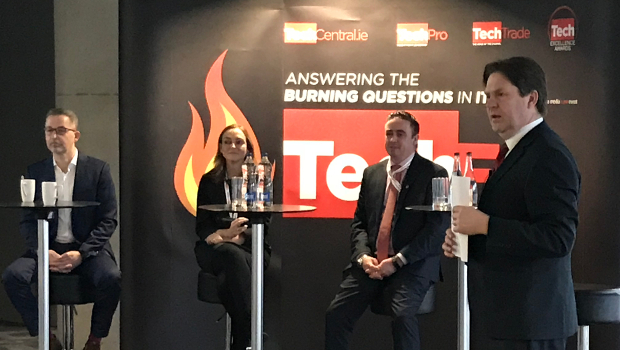
Hybrid cloud not yet mature in Ireland
While Irish organisations are widely consuming cloud services, there are still few that consider themselves as mature hybrid cloud users.
This was demonstrated by a show of hands among the attendees of the recent TechFire on unifying data, with Logicalis and NetApp. Only 10% or so of attendees felt their organisations were mature hybrid cloud users, but around two thirds confirmed they were cloud service users.
Gerard Grant, VP, Information Technology, Pramerica, spoke about how the organisation embraced cloud technologies, based on business case, but maintained the ability to access and manage data, across a diverse infrastructure of legacy mainframe, on-premises systems and cloud services, exercising not just visibility, but security and regulatory obligations.
At the panel session, Sandra Dunne, sales manager, DCS division, Logicalis, said the show of hands was unsurprising, as everyone is on a journey, and most organisations seem to have a ‘level of embarrassment” where they think that everyone else is further ahead of them than they actually are.
The common thing we see, said Dunne, is that everyone is on a journey and while there are some “shinning lights”, most have IT departments that are having to evolve in a fast moving market and so have reacted to different pressures as to where to go, resulting in a lot of variation.
But really, it is all about the data, Dunne asserted, knowing where it is, how its accessible, the nature of it and what can be done with it. Irrespective of where people are on the overall journey, these are the goals to derive value from the data.
This was echoed by Andreas Limpak, director of engineering solutions, Ireland UK, NetApp.
“The way people adopt cloud or hybrid cloud, really varies from customer to customer. For some, it is a little loose, for others it is more structured, but it is usually driven by need.”
That need must be acknowledged though, for fear of shadow IT, warned Dunne, where sometimes a credit card bill is the first indication of usage.
Going quiet
Grant said when your IT customers, internally, go quiet on cloud, it is often because they are already doing it. He warned about letting a situation develop where they self-procure. Give them what they need and allow them the security to know they can achieve their goals with approved tools and services that can be policy managed, he advised.
A comment from the audience added it comes down to choice for organisations, but that awareness of legacy within the infrastructure and application landscape was vital.
It is only when you can put these technologies together in an end-to-end strategy, said the attendee, that it really becomes interesting, especially when the organisation has a lot of legacy IT to deal with.
“You need to embrace your legacy, that’s the core of it, and then understand through a strategy what can be achieved.”
This was broadly supported by the panellists.
Leap frogging
Another question was asked in the context of a public sector organisation that has modernised a few years ago but still has not moved beyond a lot of paper processes, how can such an organisation transition quickly, or maybe take several steps forward at once?
Grant advised that his department has an evaluation group for looking at and incubating new technologies and ideas to see assess feasibility, to see if they can be done in the cloud. He acknowledged that embracing legacy technology is very important too, because even with a new service, chances are that it will be taking a feed or linking to a legacy technology somewhere.
He advised the attendee to start with the smallest application possible, a simple project to gain confidence and show what can be done. Identify quick wins to show the promise, and that will open the conversations.
The attendee said that the real challenge was making the case to senior management.
For us, said Grant, it is often the appropriate use of capital argument: are we better spending ourselves on infrastructure to run something, or can we get the same from a provider and still achieve the desired outcome.
Grant advised the minimum viable product method, the least that can be done to achieve something and demonstrate business value.
Logicalis’ Dunne said you have to pick particular use cases. Email, with the likes of Office 365, she said, is a good example to show a complex service with diverse needs, can be done and consumed as a service. Other services too, such as disaster recovery as a service and back-up as a service can also demonstrate the tasks that can be consumed easily from a provider.
Limpak recommended simplification of the arguments. It boils down to why you need to do something, he said, to streamline operations, open new revenue streams or be better and faster than your competitors. Evaluate workloads and projects on this basis to see what the business case is, he advised.
Data governance
Another question from the audience asked about the challenges in maintaining data governance across hybrid infrastructure.
Grant said for them, this was managed by a committee at global level, but was usually an issue either of education to know what goes where, or classification to easily identify data to put it in the right place with the proper protections
Finally, a question was put to Grant regarding budgets for service usage and adoption.
Grant said specific metrics, such as cost per user per year, were strictly enforced, even when talking about cloud services. There was no unlimited budget to go to the cloud.
He added that there was also an expectation that return on investment would be expected sooner simply due to the nature of a cloud service being more readily available.
We can stand up infrastructure quicker, said Grant, and there is an expectation that returns in those investments will come in quicker.
TechCentral Reporters





Subscribers 0
Fans 0
Followers 0
Followers